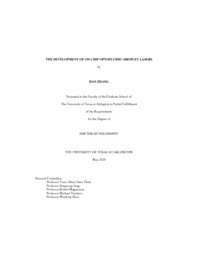
ATTENTION: The works hosted here are being migrated to a new repository that will consolidate resources, improve discoverability, and better show UTA's research impact on the global community. We will update authors as the migration progresses. Please see MavMatrix for more information.
Show simple item record
| dc.contributor.advisor | Sun, Yuze | |
| dc.creator | Zhang, Han | |
| dc.date.accessioned | 2022-07-14T16:19:00Z | |
| dc.date.available | 2022-07-14T16:19:00Z | |
| dc.date.created | 2020-05 | |
| dc.date.issued | 2020-05-19 | |
| dc.date.submitted | May 2020 | |
| dc.identifier.uri | http://hdl.handle.net/10106/30696 | |
| dc.description.abstract | Optofluidic lasers have been an emerging field for the applications of biological sensing and diagnosis, chemical sensing, and point-of-care devices. Droplets, as optical cavities, confines whispering gallery modes with high quality factors in small volumes. Optofluidic droplet lasers have brought the droplet-based microfluidics and droplets as micro-resonators to one platform, showing potentials on applications in highly sensitive bio/chemical detection, tunable lasers, cell tracking and tissue imaging. Until now, optofluidic droplet lasers can be categorized into two types, static droplet lasers and droplet lasers on the flow. Static droplet lasers offer long lifetime for biosensing, while droplet lasers on the flow produce highly monodisperse droplets with high throughput.
My research has been mostly focused on building a platform that can combine the advantages from both static droplet lasers and droplet lasers on the flow. Firstly, we demonstrated an optofluidic droplet dye laser that is generated by an array of microfluidic nozzles fabricated on a polycarbonate chip, showing a new approach to generating on-chip laser source and laser arrays in a simple, reproducible, reconfigurable, and low-cost fashion. Next, we transfer the same idea with similar design to a Si-based platform and achieved a reconfigurable 2x2 droplet laser array, which has great potentials in applications of on-chip spectroscopic analysis and point-of-care systems. Besides the conventional spectrum-based lasing threshold analysis method, we developed an image-based method to measure the lasing thresholds of droplet lasers from their lasing images, offering a low-cost method for the lasing characterization of droplet-based microlasers. Due to the liquid-liquid interface of droplet lasers, we reported an optofluidic droplet laser with a monolayer gain at the surface of droplets. The monolayer gain configuration fully resonates with the nature of whispering gallery modes and all the gain molecules participate in the lasing emission, leading to a low lasing-threshold system. The monolayer configuration also provides insights on the molecular density on the surface of droplets, enabling the study of molecular spacing in certain biological models. Lastly, to truly combine the long lifetime of static droplet lasers and the highly controlled size generation of droplet lasers on the flow into one platform, a pneumatic method was applied to control the size in droplet generation. With a LabView feedback control program, we achieved a droplet-on-demand on-chip optofluidic laser. This platform will offer great potentials for intra-cavity and interfacial-cavity sensing applications. | |
| dc.format.mimetype | application/pdf | |
| dc.language.iso | en_US | |
| dc.subject | Optofluidic lasers | |
| dc.subject | Droplet lasers | |
| dc.title | THE DEVELOPMENT OF ON-CHIP OPTOFLUIDIC DROPLET LASERS | |
| dc.type | Thesis | |
| dc.date.updated | 2022-07-14T16:19:01Z | |
| thesis.degree.department | Electrical Engineering | |
| thesis.degree.grantor | The University of Texas at Arlington | |
| thesis.degree.level | Doctoral | |
| thesis.degree.name | Doctor of Philosophy in Electrical Engineering | |
| dc.type.material | text | |
| dc.creator.orcid | 0000-0002-8555-252X | |
Files in this item
- Name:
- ZHANG-DISSERTATION-2020.pdf
- Size:
- 3.665Mb
- Format:
- PDF
This item appears in the following Collection(s)
Show simple item record


